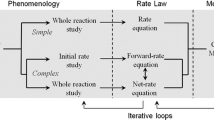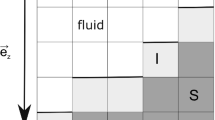Abstract
Following a recent suggestion of a new rate equation specifically for the batch dissolution of salts in solutions containing a common ion, this paper describes an analytic solution to its integration. The equation has been tested by dissolving 250 μm gypsum- rock particles in water (26.7 g l−1) containing various mixtures of sodium and calcium chlorides, all at an ionic strength of 0.060 M. The model fitted the experimental curves very well and showed that the dissolution slowed slightly overall when the initial calcium concentration was increased from 0 to 0.020 M. The dissolution curves were also modelled as a simple exponential, whence the fit was comparable to that with the new equation, with the exponential rate constant varying between 0.025 and 0.019 (±0.0004) for 0 and 0.020 M initial calcium concentration, respectively. Conventional Electrolyte theory from thermodynamics is used to show that the new equation is an inevitable consequence of modelling the net rate of dissolution in terms of a back reaction that is first order with respect to the dissolved substance, as per the recently described Shrinking Object model. Moreover, it is shown how the simple exponential model (which is a well-used plot in dissolution kinetics) provides the linear end-member to an infinite number of curvilinear plots of rate of dissolution versus reaction progress developed by the new model—it is the special case where common ion is absent. The results are now judged good enough to identify a generic batch dissolution rate equation for all salts dissolving without significant complication from either contaminants or their own gaseous species, as in calcium carbonate dissolution.






Similar content being viewed by others
References
Aagaard P, Helgeson HC (1982) Thermodynamic and kinetic constraints on reaction rates among minerals and aqueous solutions. 1. Theoretical considerations. Am J Sci 282:237–285
Arvidson RS, Lüttge A (2010) Mineral dissolution kinetics as a function of distance from equilibrium—new experimental results. Chem Geol 269:79–88
Arvidson RS, Ertan IE, Amonette JE, Lüttge A (2003) Variation in calcite dissolution rates: a fundamental problem? Geochim Cosmochim Acta 67:1623–1634
Balbach S, Korn C (2004) Pharmaceutical evaluation of early development candidates—‘the 100 mg-approach’. Int J Pharm 275:1–12
Bircumshaw LL, Riddiford AC (1952) Transport control in heterogeneous reactions. Q Rev 6:157–185
Bunnett JF (1974) From kinetic data to reaction mechanism. In: Lewis ES (ed) Techniques of chemistry vol. VI: investigation of rates and mechanisms of reactions, (part 1). Wiley-Interscience, New York, pp 129–210
Christoffersen J, Christoffersen MR (1976) The kinetics of dissolution of calcium sulphate dehydrate in water. J Cryst Growth 35:79–88
Colombani J (2008) Measurement of the pure dissolution rate constant of a mineral in water. Geochim Cosmochim Acta 72:5634–5640
Colombani J, Bert J (2007) Holographic interferometry study of the dissolution and diffusion of gypsum in water. Geochim Cosmochim Acta 71:1913–1920
Compton RG, Daly PJ (1987) The dissolution/precipitation kinetics of calcium carbonate: an assessment of various kinetic equations using a rotating disk method. J Colloid Interface Sci 115:493–498
Dove PM, Han N, De Yoreo JJ (2005) Mechanisms of classical crystal growth theory explain quartz and silicate dissolution behavior. PNAS 102:15357–15362
Eisenlohr L, Meteva K, Gabrovšek F, Dreybridt W (1999) The inhibiting action of intrinsic impurities in natural calcium carbonate minerals to their dissolution kinetics in aqueous H2O-CO2 solutions. Geochim Cosmochim Acta 63:989–1002
Erga O, Terjesen SG (1956) Kinetics of the heterogeneous reaction of calcium bicarbonate of formation with special reference to copper ion inhibition. Acta Chemica Scandanavica 10:872–874
Gradshteyn I, Ryzhik I (1965) Tables of integrals, series and products, 4th edn. Academic Press, London
Greenwood JE, Truesdale VW, Rendell AR (2001) Biogenic silica dissolution in seawater—in vitro chemical kinetics. Prog Oceanogr 48:1–23
Greenwood JE, Truesdale VW, Rendell AR (2005) Toward an understanding of biogenic-silica dissolution in seawater—an initial rate approach applied between 40 and 90 °C. Aquat Geochem 11:1–20
Helgeson HC, Murphy WM, Aagaard P (1984) Thermodynamic and kinetic constraints on reaction rates among minerals and aqueous solutions. II. Rate constants, effective surface area, and the hydrolysis of feldspar. Geochim Cosmochim Acta 48:2405–2432
Icenhower JP, McGrail BP, Shaw WJ, Pierce EM, Nachimuthu P, Shuh DK, Rodriguez EA, Steele JL (2008) Experimentally determined dissolution kinetics of Na-rich borosilicate glass at far from equilibrium conditions: implications for transition state theory. Geochim Cosmochim Acta 72:2767–2788
Jeschke AA, Dreybrodt W (2002) Dissolution rates of minerals and their relation to surface morphology. Geochim Cosmochim Acta 66:3055–3062
Kamatani A, Riley JP, Skirrow GJ (1980) The dissolution of opaline silica of diatom tests in seawater. Oceanogr Soc Japan 36:201–208
Kaufmann G, Dreybrodt W (2007) Calcite dissolution kinetics in the system CaCO3-H2O-CO2 at high undersaturation. Geochim Cosmochim Acta 71:1398–1410
Kuechler R, Noack K, Zorn T (2004) Investigation of gypsum dissolution under saturated and unsaturated water conditions. Biol Model 176:1–14
Lasaga AC (1981) Transition state theory. In: Lasaga AC, Kirkpatrick RJ (eds) Kinetics of geochemical processes. Reviews in mineralogy, vol 8. Mineralogical Society of America, Washington DC, pp 261–319
Lebedev AL, Lekhov AV (1990) Dissolution kinetics of natural gypsum in water at 5–25 °C. Geochem Int 27:85–94
Lewis GN, Randall M (1923) Thermodynamics, 1st edn. McGraw-Hill, London
Liu S-T, Nancollas GH (1971) The kinetics of dissolution of calcium sulfate dihydrate. J Inorg Nucl Chem 33:2311–2316
Lüttge A, Winkler U, Lasaga AC (2003) Interferometric study of the dolomite dissolution: a new conceptual model for mineral dissolution. Geochim Cosmochim Acta 67:1099–1116
Morse JW, Arvidson RS, Lüttge A (2007) Calcium carbonate formation and dissolution. Chem Rev 107:342–381
Nestaas I, Terjesen SG (1969) The inhibitory effects of scandium ions upon the dissolution of calcium carbonate. Acta Chem Scandanavica 23:2519–2531
O’Connor TL, Greenberg SA (1958) The kinetics for solution of silica in aqueous solutions. J Phys Chem 63:1195–1198
Petrovich R (1981) Kinetic of dissolution of mechanically comminuted rock-forming oxides and silicates—II. Deformation and dissolution of oxides and silicates in the laboratory and at the earth’s surface. Geochim Cosmochim Acta 45:1675–1686
Plummer LN, Wigley TML (1976) The kinetics of calcite dissolution in CO2-saturated solutions at 25 °C and 1 atmosphere pressure. Geochim Cosmochim Acta 40:191–202
Plummer LN, Wigley TML, Parkhurst DL (1978) The kinetics of calcite dissolution in CO2-water systems at 5° to 60 °C and 0.0 to 1.0 ATM CO2. Am J Sci 278:179–216
Press WH, Teukolsky SA, Vetterling WT, Flannery BP (1999) Numerical recipies in Fortran 77: the art of scientific computing, 2nd edn. Cambridge University Press, Cambridge
Raines MA, Dewers TA (1997) Mixed transport/reaction control of gypsum dissolution kinetics in aqueous solutions and initiation of gypsum karst. Chem Geol 140:29–48
Rickard D, Sjöberg EL (1983) Mixed kinetic control of calcite dissolution rates. Am J Sci 283:815–830
Rickert D, Schlüter M, Wallman K (2002) Dissolution kinetics of biogenic silica from the water column to the sediments. Geochim Cosmochim Acta 66:439–455
Robinson RA, Stokes RH (1959) Electrolyte solutions, 2nd edn. Butterworths, London
Saldi GD, Schott J, Pokrovsky OS, Oelkers EH (2010) An experimental study of magnesite dissolution rates at neutral to alkaline conditions and 150 and 200 °C as a function of pH, total dissolved carbonate concentration, and chemical affinity. Geochim Cosmochim Acta 74:6344–6356
Schott J, Pokrovsky OS, Oelkers EH (2009) The link between mineral dissolution/precipitation kinetics and solution chemistry. Rev Mineral Geochem 70:207–258
Sjöberg EL (1976) A fundamental equation for calcite dissolution kinetics. Geochim Cosmochim Acta 40:441–447
Sjöberg EL, Rickard D (1985) The effect of added dissolved calcium on calcite dissolution kinetics in aqueous solutions at 25 °C. Chem Geol 49:405–413
Sohn HY, Wadsworth ME (1979) Rate processes in extractive metallurgy. Plenum, New York. ISBN 0 306 31102-X
Svensson U, Dreybrodt W (1992) Dissolution kinetics of natural calcite minerals in CO2-water systems approaching calcite equilibrium. Chem Geol 100:129–145
Talman SJ, Nesbitt HW (1988) Dissolution of populations of ultrafine grains with applications to feldspars. Geochim Cosmochim Acta 52:1467–1471
Terjesen SG, Erga O, Thorsen G, Ve A (1961) The inhibitory action of metal ions on the formation of calcium bicarbonate by the reaction of calcite with aqueous carbon dioxide. Chem Eng Sci 74:277–288
Truesdale VW (2007) Batch dissolution kinetics: the shrinking sphere model with salts and its potential application to biogenic silica. Aquat Geochem 13:267–287. doi:10.1007/s10498-007-9020-1
Truesdale VW (2008) Shrinking sphere kinetics for batch dissolution of mixed particles of a single substance at high under-saturation—validation with sodium chloride, but with biogenic silica in mind. Aquat Geochem 14:359–379. doi:10.1007/s10498-008-9041-4
Truesdale VW (2009) Sucrose dissolution studies leading to a generic shrinking object model for batch dissolution of regular-shaped particles. Aquat Geochem 15:421–442. doi:10.1007/s10498-008-9059-7
Truesdale VW (2010) Silica gel as a surrogate for biogenic silica in batch dissolution experiments at pH 9.2: further testing of the shrinking object model and a novel approach to the dissolution of a population of particles. Aquat Geochem 16:101–126. doi:10.1007/s10498-009-9072-5
Truesdale VW (2011a) Generic issues of batch dissolution exemplified by gypsum rock. Aquat Geochem 17:21–50. doi:10.1007/s10498-010-9105-0
Truesdale VW (2011b) Rate equations and an ion-pair mechanism for batch dissolution of gypsum: repositioning the shrinking object model at the core of hydrodynamics. Aquat Geochem 17:141–164. doi:10.1007/s10498-010-9112-1
Truesdale VW (2011c) Tidying up the environment: a journey from exponential curves to hydrodynamics in environmental batch dissolutions. Pure Appl Chem, ASAP Article. doi:10.1351/PAC-CON-10-08-13
Truesdale VW (2012) Unifying batch-dissolution kinetics for salts: probing the back reaction for gypsum and calcite by means of the common ion effect. Aquat Geochem. doi:10.1007/s10498-012-9158-3 (in press)
Truesdale VW, Greenwood JE, Rendell AR (2005a) The rate-equation for biogenic silica dissolution in seawater—new hypotheses. Aquat Geochem 11:319–343. doi:10.1007/s10498-004-7921-9
Truesdale VW, Greenwood JE, Rendell AR (2005b) In vitro, batch-dissolution of biogenic silica in seawater—the application of recent modelling to real data. Progr Oceanogr 66:1–24. doi:10.1016/j.pocean.2005.02.019
Van Cappellen P, Qiu L (1997) Biogenic silica in sediments of the Southern Ocean. II. Kinetics. Deep Sea Res Part II Top Stud Oceanogr 44:1129–1149. doi:10.1016/S0967-0645(96)00112-9
Villegras-Jiménez A, Mucci A, Pokrovsky OS, Schott J (2009) Defining reactive sites on hydrated mineral surfaces: rhombohedral carbonate minerals. Geochim et Cosmochim Acta 73:4326–4345
Vinson MD, Arvidson RS, Lüttge A (2007) Kinetic inhibition of calcite (1 0 4) dissolution by aqueous manganese(II). J Cryst Growth 307:116–125
Wolff-Boenisch D, Gislason SR, Oelkers EH, Putnis CV (2004) The dissolution rates of natural glasses as a function of their composition at pH 4 and 10.6, and temperatures from 25 to 74 °C. Geochim Cosmochim Acta 68:4843–4858
Zhang L, Lüttge A (2009) Theoretical approach to evaluating plagioclase dissolution mechanisms. Geochim Cosmochim Acta 73:2832–2849
Acknowledgments
Thanks go to Professors Heinz Gamsjäger and Mike Whitfield for long-standing discussions of the thermodynamics within this project. Stephen Casterton, Regional Technical Services Manager, BPB, Newark, UK, who supplied the gypsum rock, is also thanked greatly. We thank the referees for their efforts in improving the original manuscript.
Author information
Authors and Affiliations
Corresponding author
Rights and permissions
About this article
Cite this article
Truesdale, V.W., Sebu, C. A New Analytic Integration of the Rate Equation for Batch Dissolution of Salts in the Presence of Common Ion. Aquat Geochem 19, 39–56 (2013). https://doi.org/10.1007/s10498-012-9177-0
Received:
Accepted:
Published:
Issue Date:
DOI: https://doi.org/10.1007/s10498-012-9177-0




